Personality and sound: Akio Morita - the history of hereditary sakedzukuri, the path of the creator of SONY
It is always interesting for me to write about the Japanese, sometimes even more than about the Russians. Personal stories of prominent representatives of this nation are always very colorful and full of events that could hardly happen in continental Europe or the USA. The typical story of a Japanese start-up inventor and a self-made entrepreneur is the plot of the Russian saying “From Dirt to Riches”. The most demonstrative in this regard are Konosuke Matsushita and Torasuku Yamaha, who were able to create a business out of nothing, relying only on their own strength, love of technology and inventions.

Akio Morita stands out from this slim concept. His story is rather a story about risk, for the sake of a beloved business. The risk of losing wealth and trampling the family tradition, which in Japan of the mid-20th century was never welcomed. The life of this Japanese inventor and businessman is a challenge to the circumstances that push a person to walk the beaten paths. Akio Morita risked at least his reputation, putting at stake the development of family business and the honor of his family. Since today it is difficult to find a person who would not know about SONY, he certainly won this game against the fate that seemed to determine his future.
Akio Morita was born in Nagaya, in a family that for fifteen generations (many even for Japan) was engaged in the production of sake, January 26, 1921. Masters of the production of sake called sakezukuri. Their prescription secrets are passed down from generation to generation. Due to the fact that Akio was the eldest child in the family, he was pinned his hopes on and from childhood taught the secrets of making the most respected drink in Japan and the basics of management (a company that produces sake). According to some sources, the Morita family was one of the suppliers of the Japanese imperial court and the Tokugawa shogunate from the 16th century.
It is quite natural that the childhood of the future founder of SONY was in abundance. Akio lived in the center of one of the largest cities in the country, in a large house, in the courtyard of which a tennis court was located. It should be noted here that the majority of sake producers in parallel were usurers (the usury tradition among sakedzukuri dates back several centuries), which made them one of the richest people in Japan.

Despite the efforts of the family, Akio showed a greater interest in electronics than in the family secrets of alcohol production. It is known that from an early age he was interested in electrical sound recording. In one of the businessman’s biographies, he shares his first youthful impressions of an article about the invention of a tape recorder (very rare in his childhood): “I was shocked by this new discovery.”
Hot enthusiasm for the future innovator and billionaire electronics negatively affected his school success. In his interviews, he repeatedly noted that instead of preparing homework, he was engaged in the study of physics and electrical devices. In his childhood, almost all of his free time, Akio spent on experiments with electrical devices, studying physical phenomena that interested him, reading Popular Mechanics, as well as other literature related to electronics and advances in science and technology.
As I have already noted, from early childhood, Akio gained experience as a manager. His father took him to the board of directors of the company from the age of 10. Having already become an experienced businessman, Akio noted that the techniques and management skills he had received in childhood were indispensable in big business. It is also known that, as a child, he could not bear the boring father's meetings.
By the last classes of high school, Akio's passion was driving the curve of his performance to the lower limit on the graph. Learning problems threatened to become an academic fiasco of a young researcher. Especially, given that he already realized the value of education and sought to enroll in the scientific department of the Eighth Nagaya Secondary School (at that time one of the best secondary schools in Japan).
With a lot of effort, Akio overcame the backlog and achieved the goal. After graduation, he successfully enrolled at the Imperial College in Osaka, after which he became a graduated physicist.
The young Japanese survived the war comparatively calmly without experiencing its hardship and deprivation, mainly due to the good financial condition of the family. During the war years, like most Japanese scientists, he was mobilized and received an officer rank in the Imperial fleet. At this time, Akio works in a research committee and participates in the creation of marine and aviation equipment.

During this period, he met with the engineer and technical genius Mazaro Ibuka. Assessing the remarkable potential of a colleague, after the war, Morita begins to dream of creating a Japanese company that will produce electronic devices. It is interesting that at that moment Mazaro had less ambitious plans, he just wanted to make money on the production of demanded radio components.
Immediately after the end of the second world, Morita seriously thought about his own business. He was well aware that he was not at all drawn to accept the reins of government in a family enterprise. In 1945, Morita worked as a teacher of physics in Tokyo, and also spent some time in the optical laboratory. Low wages and cramped social conditions bothered the engineer, accustomed to a relatively full life, which prompted him to action.
On May 7, 1946, Morita and Ibuka founded the Tokyo Telecommunications Technical Company (abbreviated Totsuko or TTK). The modest initial capital of the company was about $ 500 (today, taking into account inflation, it is about $ 6,500). Ibuka was able to organize a small team of scientists and engineers who wanted to develop new equipment.

There was practically no production base. The first startup that started companions - was a device for cooking rice. They managed to produce in the amount of one hundred pieces. Sold - zero. War-ravaged Japanese did not consider it necessary to automate the preparation of food, quite content with traditional methods. There were a number of products that the market perceived ambiguously, or simply ignored, which forced the founders to think seriously about the changes.
According to Morita himself, the reasons for their failures in the first stage of development were marketing and sales organization. They didn’t have any idea what the market wanted and didn’t know how to properly present the products; the matter was complicated by the plight of the country defeated in World War II.
It was Morita who realized the main problems of the young company and began to seriously study the market. Over time, he completely stopped research and design, concentrating on generating new technical concepts and trying to understand what the market needed.
While the “young fast-growing company” was trying to reach the market, it was suffering losses. In this situation, she needed serious investment support. Despite the unacceptable, from the point of view of tradition, ignoring the family business, Morita received regular financial support from his father. As an experienced sakezukuri and a good businessman, he intuitively felt that his son’s company has prospects.
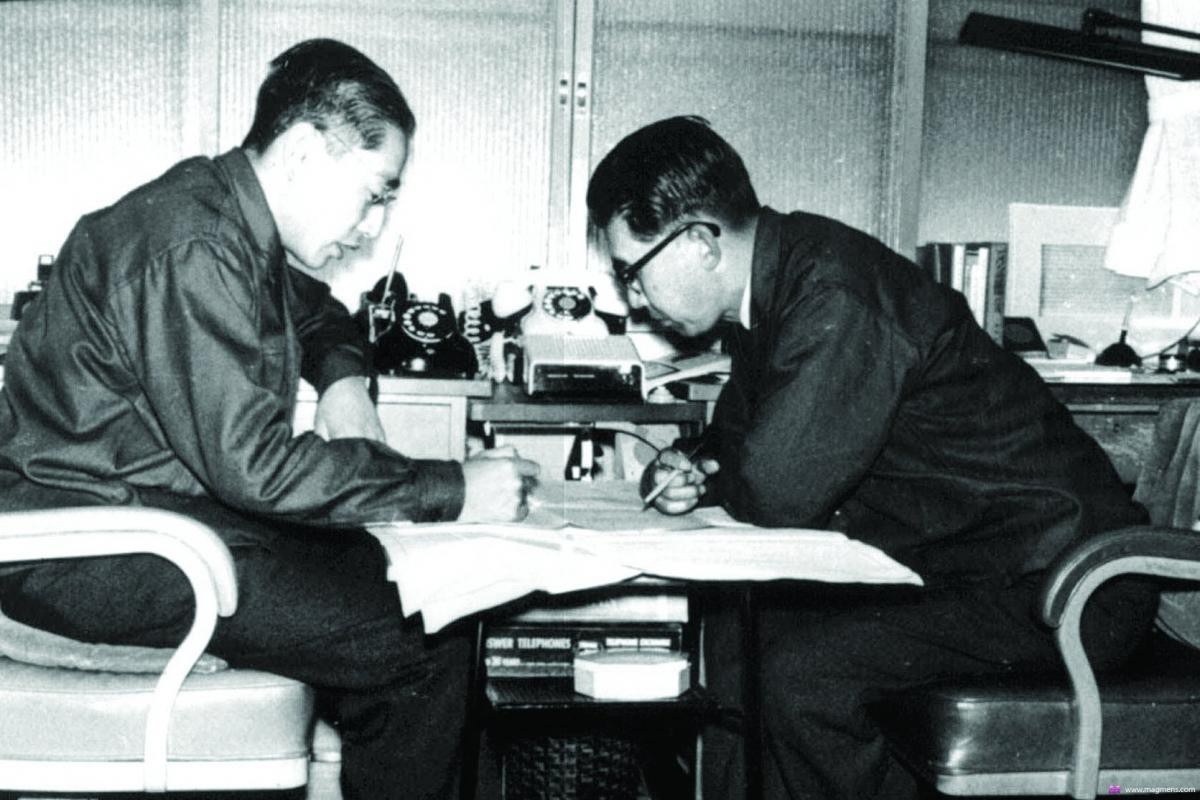
It can be said that in the 40s the development of the new products of the Tokyo Telecommunications Technical Company was paid for by income from the sale of alcohol. It is hard for me to imagine what Russian engineers could achieve if they introduced this practice in our country. In fact, each purchased bottle of sake, made at the enterprise of the Morita family, contributed to the development of the future industrial giant.
In the late forties, Morita had the opportunity to purchase a thing, the invention of which struck him so much in childhood - a tape recorder. He purchased an American wire reel device (at the time there were no others), naturally used. The team began experiments in order to create a counterpart for domestic needs. A tape recorder in the forties was at the height of technical thought, especially in Japan, where it was engaged in consumer electronics at that time, except perhaps Konosuke Matsushita.
After careful study, a team of researchers came to the conclusion that the wire carrier is extremely inconvenient and tape is needed for household use. Months of intense experimentation have borne fruit. After several unsuccessful attempts with a paper and cellophane tape, the optimal solution was found - a polymeric material with the necessary properties.
In 1949, Totsuko’s company released the world's first tape reel tape recorder, Type G. Despite the high cost (17,000 yen), the product almost instantly gained popularity. Clients were companies and government agencies for which the use of a voice recorder was extremely necessary. In addition, the Japanese tape recorder was cheaper and more convenient than its American counterparts, moreover, no problems with the purchase of coils. The mass of the device was 35 kg.
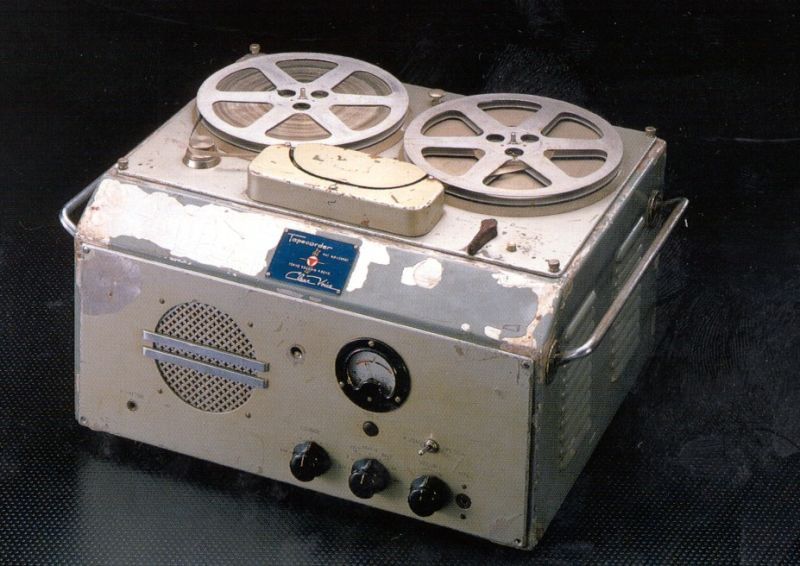
The next serial tape recorder, despite the impressive design for the 50s, could not conquer the market and caused only limited interest. Losses from the development and release of the new model were completely insensitive for Totsuko, since sales of Type G were more than enough to cover even the most daring experiments. Moreover, the popularity of Type G gave the company a starting impetus that allowed it to provide innovative development and financial stability until the 60s of the last century.
Morita and Ibuka were among the first to appreciate the benefits of semiconductors for audio production. To reduce the size and weight of the equipment, TTK acquired a license for the production of transistors from Western Electric. The purchase cost impressive for that time, but not astronomical money, only $ 25,000 (at current prices would be $ 150,000).
In 1955, the release of the first radio receiver, the TR-63, began. Thanks to the semiconductor circuitry, it was possible to make the receiver quite portable. The product was positioned as a pocket, but in fact was not included in the standard pockets of men's shirts.
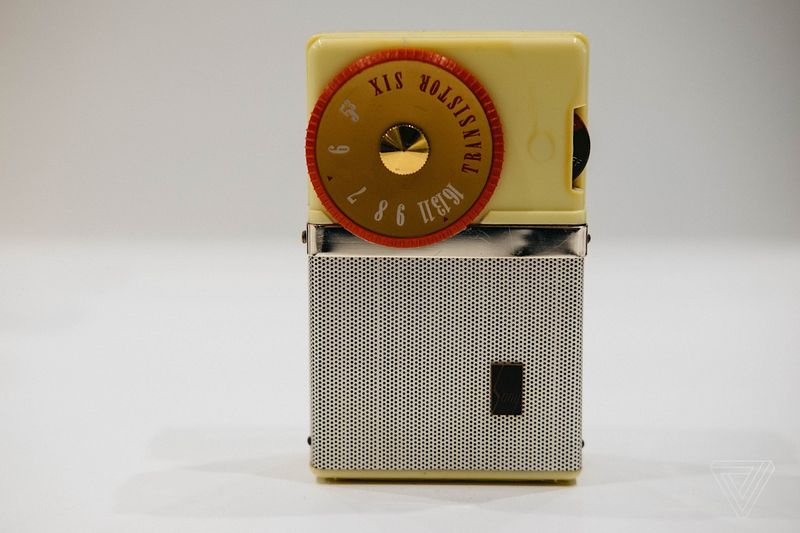
To hide the discrepancy between size and positioning, for salespeople who sold the device, they ordered special shirts with an enlarged pocket, in which the gadget was placed. It worked, and soon the new receiver began to beat Type G popularity records.
This device manifested Morita and Ibuka’s passion for portability, which would later become not only the calling card of the company, but also all Japanese electronics.
By the way, from his youth, from the moment of reading the notes on the invention of the tape recorder, Morita is dreaming about creating a portable device that will allow you to listen to music on the road, in other words about the player.
By the mid-50s, Totsuku products became popular outside of Japan. The new company began to offer tape recorders and radio sets to the western market, which were not inferior in quality to their native counterparts, while their cost was lower than that of the American and German ones. Morita, already podatorevshiy in marketing, realized that for full-scale introduction to the western markets rebranding is necessary. According to his logical suggestion, “Tokyo tsushin kogyo”, for a European was difficult to pronounce, not memorable and not very euphonic name, and even the abbreviated “Totsuku” and “TTK” could hardly have taken root as a brand in the west.
In the 50s, the main products of the company were sound reproduction equipment. In order for the name to reflect the company's profile, Morita took the Latin word sonus (“sound”) as a basis. Japan is not rarely called the land of the rising sun. Of the options reflecting nationality, the word sunny was most consonant with “sonus”. It turned out Sonny, which was extremely inconvenient already for the Japanese themselves, since literally san-ni is “the loss of money. As a result, Akio decided to remove one letter "n", and the name completely satisfied him. As the founder later recalled, he wanted the name not to be in any language of the world. The resulting synthesis of Latin and English “Sony” fully met this requirement.
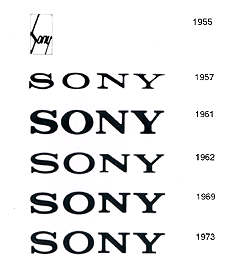
Along with the name, a simple logo was developed, based on the oblique spelling of the word SONY, later the logo changed in step with trends in the design of global brands, acquiring a form that is known to us today.
The principles of development of equipment, production, management and marketing, developed by Morita through trial and impressive errors in the 50s, began to quickly bear fruit. Since the 60s, SONY has begun to develop a new direction - television. In 1960, the world's first portable TV TV8-301 appears. The design of the device is impressive to many.

Through the efforts of specialists led by Morita and Ibuka, in 1968 the first in the world color television system, Trinitron, appeared. In 1971, the company developed a new color video format and began selling the first color video tapes and video recorders for them, while still cumbersome, but already surpassing reel-to-reel video in portability.
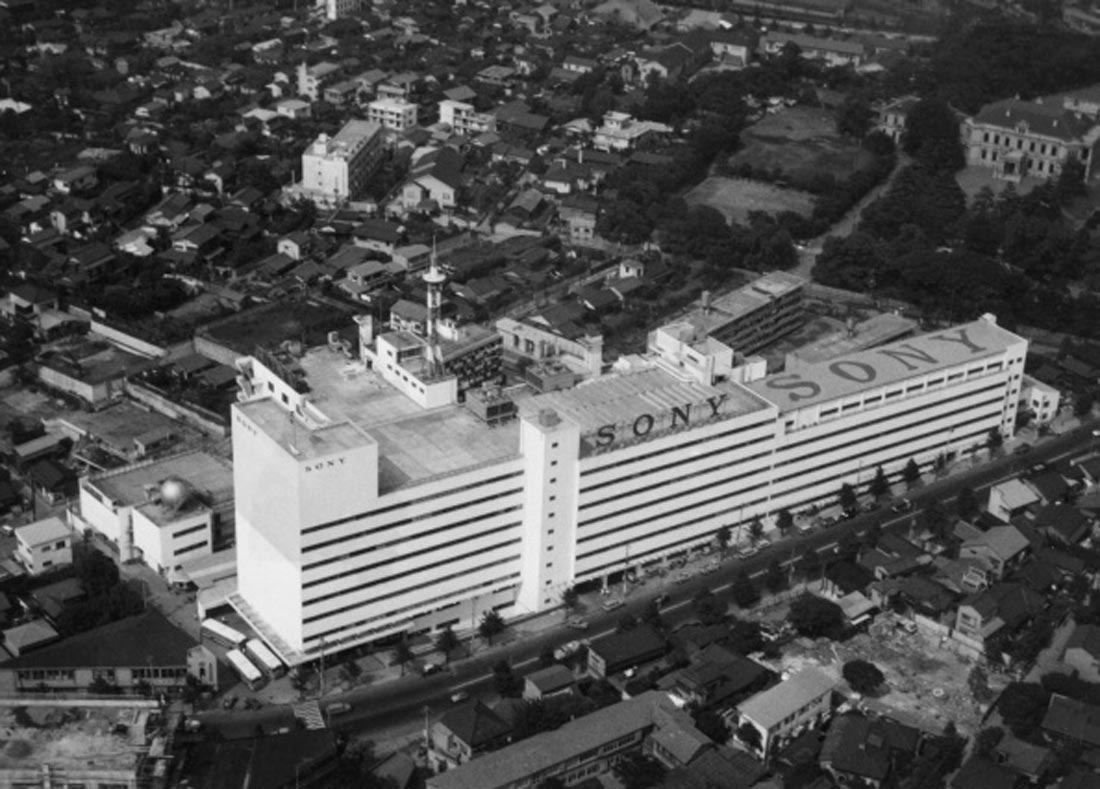
In 1978, one of the SONY engineers, Nobutoshi Kihara, realized Morita’s youthful dream by developing the world's first portable player, SonyWalkman. In 1979, the serial production of the device began, which won the hearts of millions. Surprisingly, the company "roasted with milk" was not completely confident in the success of the new product. According to the results of research conducted in the company, it turned out that a device that does not have a recording function will not become very popular.
Seeing the distrust of colleagues, Morita said:
"If we do not sell 100,000 units by the end of this year, I will give up the post of chairman of the company . "
Sales were higher than the figures voiced, Akio Morita's intuition turned out to be more accurate than the calculations of his analysts. In all the years of cassette audio player production, SONY managed to sell over 100 million copies. "SonyWalkman" was produced in more than 70 versions, and during its existence has sold more than 20 million units.
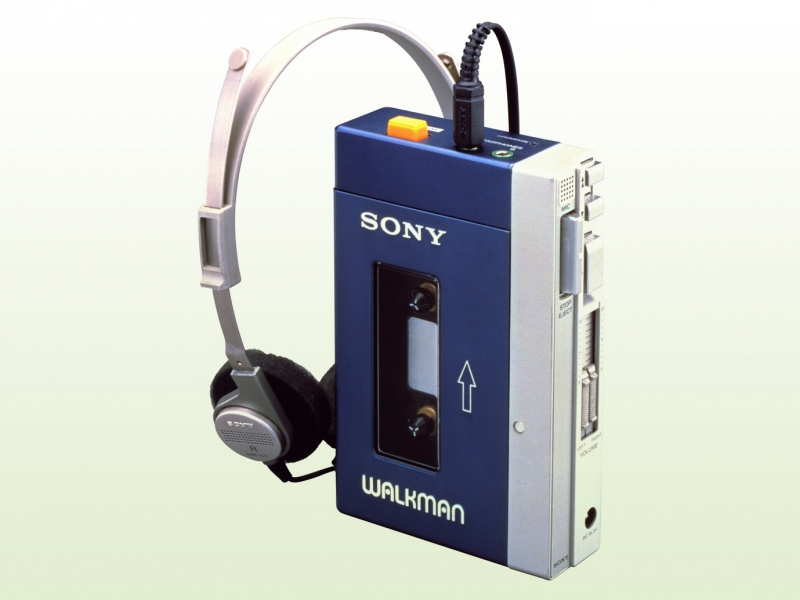
Despite the frantic popularity, Morita acknowledged that the idea of a player was an adventure. In 1986, he said the following about this: “I don’t believe that even the most extensive market research could have predicted that SonyWalkman would be a success, not to mention that it would become a sensation and cause mass copying.” Having shown his inherent firmness when making unpopular decisions and once again risking Akio Morita, he again won.

At the time of Akio Morita, SONY was one of the engines of research in the field of audio, video and photo equipment. Morita was able to choose the right personnel and bet on promising solutions. Under his leadership, the company's engineers managed to create the first cameraless camera (video camera), which became the prototype of modern digital cameras, several lines of the best VCRs and video cameras for their time, it is difficult to overestimate SONY's contribution to the development and promotion of digital audio recording formats such as CD and MiniDisc. Morita is directly involved in the implementation of all these innovations, either as the author of a leading technical concept or as a leader who made a landmark decision.

Morita, personally acquainted with Steve Jobs had a significant influence on the latter. Jobs liked the Walkman and in the 80s he rarely compared Apple computers with a SONY player. Jobs said that Apple products should become a “wolfman” in the world of computers. Like Morita, he neglected market research and was prone to adventures.

Akio Morita led the SONY until November 25, 1994. The love for tennis, which the businessman and scientist had been practicing since childhood, in old age adversely affected his health. Morita received a stroke on the court, after which he decided to work closely on health, which was incompatible with high loads while managing a global corporation. The successor of the founder was Norio Og. The new head of the corporation was invited to the company after being a user of SONY products, Akio wrote an angry letter complaining about the poor quality of the tape recorders and a description of the technical problems that led to this.
Akio successfully made his literary debut in 1966 with the book “Nothing Meaningful School Achievement” (the second version of the name: “Don't rely on school education”), in which he criticized tough academic standards and the low use of classical school education. At sunset, he wrote another bestseller, "Made in Japan", which was devoted to the history of SONY , in 2007, the book was published in Russian.
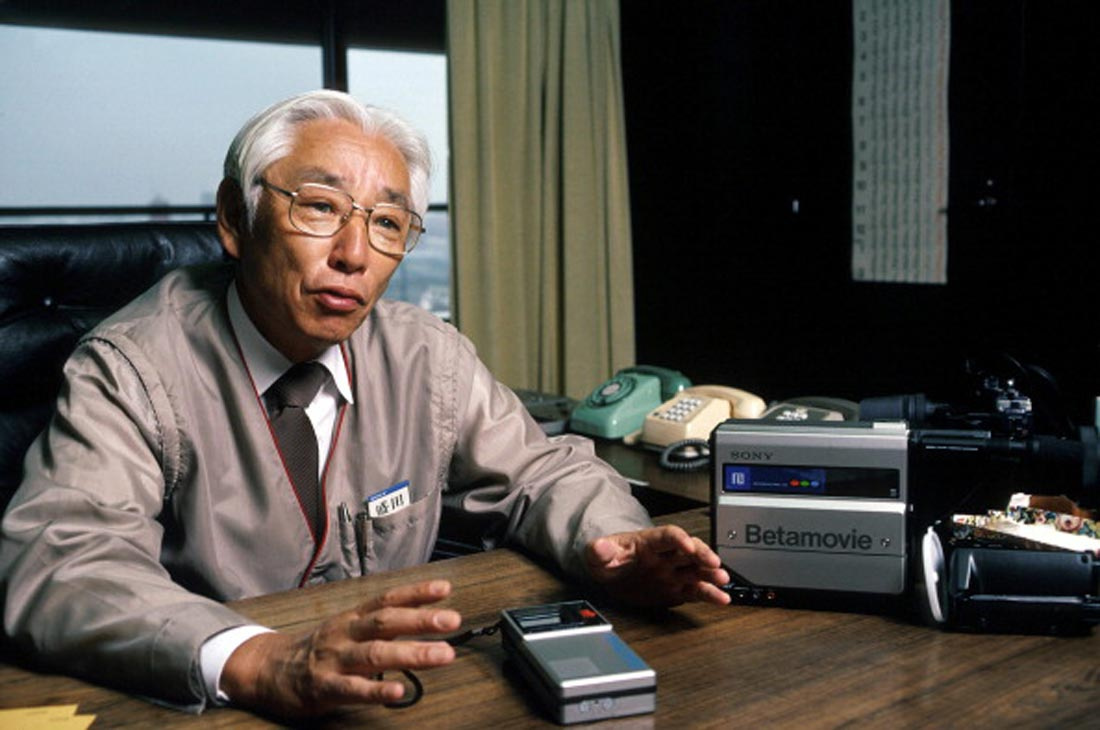
Despite the fact that Morita is considered the main violator of traditions among Japanese businessmen, his attitude to the personnel policy of the enterprise is quite traditional. Family principles of corporate culture is the same as, for example, Matsushita. This is well demonstrated by one of his statements about the American policy of layoffs, "in 1982:
“In Japan, we think of the company as a family. You can not dismiss people because of the reorganization of the enterprise. Management must sacrifice profits and share the difficulties with all. "
Morita became the first Japanese, who in 1982 was awarded the British Royal Society of Arts, the prestigious Albert Medal. In France, his achievements were noted by the National Order of the Legion of Honor (in 1984). At home, the contribution of the innovator found recognition in 1991, the emperor of Japan awarded him the Order of the Holy Treasure of the First Degree.
Akio Morita died in 1999, at the age of 78 years. The cause of death was pneumonia, which is extremely difficult to cure in old age.

Akio Morita stands out from this slim concept. His story is rather a story about risk, for the sake of a beloved business. The risk of losing wealth and trampling the family tradition, which in Japan of the mid-20th century was never welcomed. The life of this Japanese inventor and businessman is a challenge to the circumstances that push a person to walk the beaten paths. Akio Morita risked at least his reputation, putting at stake the development of family business and the honor of his family. Since today it is difficult to find a person who would not know about SONY, he certainly won this game against the fate that seemed to determine his future.
Bad heir
Akio Morita was born in Nagaya, in a family that for fifteen generations (many even for Japan) was engaged in the production of sake, January 26, 1921. Masters of the production of sake called sakezukuri. Their prescription secrets are passed down from generation to generation. Due to the fact that Akio was the eldest child in the family, he was pinned his hopes on and from childhood taught the secrets of making the most respected drink in Japan and the basics of management (a company that produces sake). According to some sources, the Morita family was one of the suppliers of the Japanese imperial court and the Tokugawa shogunate from the 16th century.
It is quite natural that the childhood of the future founder of SONY was in abundance. Akio lived in the center of one of the largest cities in the country, in a large house, in the courtyard of which a tennis court was located. It should be noted here that the majority of sake producers in parallel were usurers (the usury tradition among sakedzukuri dates back several centuries), which made them one of the richest people in Japan.

Despite the efforts of the family, Akio showed a greater interest in electronics than in the family secrets of alcohol production. It is known that from an early age he was interested in electrical sound recording. In one of the businessman’s biographies, he shares his first youthful impressions of an article about the invention of a tape recorder (very rare in his childhood): “I was shocked by this new discovery.”
Hot enthusiasm for the future innovator and billionaire electronics negatively affected his school success. In his interviews, he repeatedly noted that instead of preparing homework, he was engaged in the study of physics and electrical devices. In his childhood, almost all of his free time, Akio spent on experiments with electrical devices, studying physical phenomena that interested him, reading Popular Mechanics, as well as other literature related to electronics and advances in science and technology.
As I have already noted, from early childhood, Akio gained experience as a manager. His father took him to the board of directors of the company from the age of 10. Having already become an experienced businessman, Akio noted that the techniques and management skills he had received in childhood were indispensable in big business. It is also known that, as a child, he could not bear the boring father's meetings.
From Losers to Military Physics
By the last classes of high school, Akio's passion was driving the curve of his performance to the lower limit on the graph. Learning problems threatened to become an academic fiasco of a young researcher. Especially, given that he already realized the value of education and sought to enroll in the scientific department of the Eighth Nagaya Secondary School (at that time one of the best secondary schools in Japan).
With a lot of effort, Akio overcame the backlog and achieved the goal. After graduation, he successfully enrolled at the Imperial College in Osaka, after which he became a graduated physicist.
The young Japanese survived the war comparatively calmly without experiencing its hardship and deprivation, mainly due to the good financial condition of the family. During the war years, like most Japanese scientists, he was mobilized and received an officer rank in the Imperial fleet. At this time, Akio works in a research committee and participates in the creation of marine and aviation equipment.

During this period, he met with the engineer and technical genius Mazaro Ibuka. Assessing the remarkable potential of a colleague, after the war, Morita begins to dream of creating a Japanese company that will produce electronic devices. It is interesting that at that moment Mazaro had less ambitious plans, he just wanted to make money on the production of demanded radio components.
Immediately after the end of the second world, Morita seriously thought about his own business. He was well aware that he was not at all drawn to accept the reins of government in a family enterprise. In 1945, Morita worked as a teacher of physics in Tokyo, and also spent some time in the optical laboratory. Low wages and cramped social conditions bothered the engineer, accustomed to a relatively full life, which prompted him to action.
Unsuccessful startups paid for by Japanese drunks
On May 7, 1946, Morita and Ibuka founded the Tokyo Telecommunications Technical Company (abbreviated Totsuko or TTK). The modest initial capital of the company was about $ 500 (today, taking into account inflation, it is about $ 6,500). Ibuka was able to organize a small team of scientists and engineers who wanted to develop new equipment.

There was practically no production base. The first startup that started companions - was a device for cooking rice. They managed to produce in the amount of one hundred pieces. Sold - zero. War-ravaged Japanese did not consider it necessary to automate the preparation of food, quite content with traditional methods. There were a number of products that the market perceived ambiguously, or simply ignored, which forced the founders to think seriously about the changes.
According to Morita himself, the reasons for their failures in the first stage of development were marketing and sales organization. They didn’t have any idea what the market wanted and didn’t know how to properly present the products; the matter was complicated by the plight of the country defeated in World War II.
It was Morita who realized the main problems of the young company and began to seriously study the market. Over time, he completely stopped research and design, concentrating on generating new technical concepts and trying to understand what the market needed.
While the “young fast-growing company” was trying to reach the market, it was suffering losses. In this situation, she needed serious investment support. Despite the unacceptable, from the point of view of tradition, ignoring the family business, Morita received regular financial support from his father. As an experienced sakezukuri and a good businessman, he intuitively felt that his son’s company has prospects.

It can be said that in the 40s the development of the new products of the Tokyo Telecommunications Technical Company was paid for by income from the sale of alcohol. It is hard for me to imagine what Russian engineers could achieve if they introduced this practice in our country. In fact, each purchased bottle of sake, made at the enterprise of the Morita family, contributed to the development of the future industrial giant.
First success - tape pioneers
In the late forties, Morita had the opportunity to purchase a thing, the invention of which struck him so much in childhood - a tape recorder. He purchased an American wire reel device (at the time there were no others), naturally used. The team began experiments in order to create a counterpart for domestic needs. A tape recorder in the forties was at the height of technical thought, especially in Japan, where it was engaged in consumer electronics at that time, except perhaps Konosuke Matsushita.
After careful study, a team of researchers came to the conclusion that the wire carrier is extremely inconvenient and tape is needed for household use. Months of intense experimentation have borne fruit. After several unsuccessful attempts with a paper and cellophane tape, the optimal solution was found - a polymeric material with the necessary properties.
In 1949, Totsuko’s company released the world's first tape reel tape recorder, Type G. Despite the high cost (17,000 yen), the product almost instantly gained popularity. Clients were companies and government agencies for which the use of a voice recorder was extremely necessary. In addition, the Japanese tape recorder was cheaper and more convenient than its American counterparts, moreover, no problems with the purchase of coils. The mass of the device was 35 kg.

The next serial tape recorder, despite the impressive design for the 50s, could not conquer the market and caused only limited interest. Losses from the development and release of the new model were completely insensitive for Totsuko, since sales of Type G were more than enough to cover even the most daring experiments. Moreover, the popularity of Type G gave the company a starting impetus that allowed it to provide innovative development and financial stability until the 60s of the last century.
TR-63 - almost pocket radio
Morita and Ibuka were among the first to appreciate the benefits of semiconductors for audio production. To reduce the size and weight of the equipment, TTK acquired a license for the production of transistors from Western Electric. The purchase cost impressive for that time, but not astronomical money, only $ 25,000 (at current prices would be $ 150,000).
In 1955, the release of the first radio receiver, the TR-63, began. Thanks to the semiconductor circuitry, it was possible to make the receiver quite portable. The product was positioned as a pocket, but in fact was not included in the standard pockets of men's shirts.

To hide the discrepancy between size and positioning, for salespeople who sold the device, they ordered special shirts with an enlarged pocket, in which the gadget was placed. It worked, and soon the new receiver began to beat Type G popularity records.
This device manifested Morita and Ibuka’s passion for portability, which would later become not only the calling card of the company, but also all Japanese electronics.
By the way, from his youth, from the moment of reading the notes on the invention of the tape recorder, Morita is dreaming about creating a portable device that will allow you to listen to music on the road, in other words about the player.
Rebranding
By the mid-50s, Totsuku products became popular outside of Japan. The new company began to offer tape recorders and radio sets to the western market, which were not inferior in quality to their native counterparts, while their cost was lower than that of the American and German ones. Morita, already podatorevshiy in marketing, realized that for full-scale introduction to the western markets rebranding is necessary. According to his logical suggestion, “Tokyo tsushin kogyo”, for a European was difficult to pronounce, not memorable and not very euphonic name, and even the abbreviated “Totsuku” and “TTK” could hardly have taken root as a brand in the west.
In the 50s, the main products of the company were sound reproduction equipment. In order for the name to reflect the company's profile, Morita took the Latin word sonus (“sound”) as a basis. Japan is not rarely called the land of the rising sun. Of the options reflecting nationality, the word sunny was most consonant with “sonus”. It turned out Sonny, which was extremely inconvenient already for the Japanese themselves, since literally san-ni is “the loss of money. As a result, Akio decided to remove one letter "n", and the name completely satisfied him. As the founder later recalled, he wanted the name not to be in any language of the world. The resulting synthesis of Latin and English “Sony” fully met this requirement.

Along with the name, a simple logo was developed, based on the oblique spelling of the word SONY, later the logo changed in step with trends in the design of global brands, acquiring a form that is known to us today.
The victorious march of SONY and Akio Morita at the zenith of glory
The principles of development of equipment, production, management and marketing, developed by Morita through trial and impressive errors in the 50s, began to quickly bear fruit. Since the 60s, SONY has begun to develop a new direction - television. In 1960, the world's first portable TV TV8-301 appears. The design of the device is impressive to many.

Through the efforts of specialists led by Morita and Ibuka, in 1968 the first in the world color television system, Trinitron, appeared. In 1971, the company developed a new color video format and began selling the first color video tapes and video recorders for them, while still cumbersome, but already surpassing reel-to-reel video in portability.

In 1978, one of the SONY engineers, Nobutoshi Kihara, realized Morita’s youthful dream by developing the world's first portable player, SonyWalkman. In 1979, the serial production of the device began, which won the hearts of millions. Surprisingly, the company "roasted with milk" was not completely confident in the success of the new product. According to the results of research conducted in the company, it turned out that a device that does not have a recording function will not become very popular.
Seeing the distrust of colleagues, Morita said:
"If we do not sell 100,000 units by the end of this year, I will give up the post of chairman of the company . "
Sales were higher than the figures voiced, Akio Morita's intuition turned out to be more accurate than the calculations of his analysts. In all the years of cassette audio player production, SONY managed to sell over 100 million copies. "SonyWalkman" was produced in more than 70 versions, and during its existence has sold more than 20 million units.

Despite the frantic popularity, Morita acknowledged that the idea of a player was an adventure. In 1986, he said the following about this: “I don’t believe that even the most extensive market research could have predicted that SonyWalkman would be a success, not to mention that it would become a sensation and cause mass copying.” Having shown his inherent firmness when making unpopular decisions and once again risking Akio Morita, he again won.

At the time of Akio Morita, SONY was one of the engines of research in the field of audio, video and photo equipment. Morita was able to choose the right personnel and bet on promising solutions. Under his leadership, the company's engineers managed to create the first cameraless camera (video camera), which became the prototype of modern digital cameras, several lines of the best VCRs and video cameras for their time, it is difficult to overestimate SONY's contribution to the development and promotion of digital audio recording formats such as CD and MiniDisc. Morita is directly involved in the implementation of all these innovations, either as the author of a leading technical concept or as a leader who made a landmark decision.

Morita, personally acquainted with Steve Jobs had a significant influence on the latter. Jobs liked the Walkman and in the 80s he rarely compared Apple computers with a SONY player. Jobs said that Apple products should become a “wolfman” in the world of computers. Like Morita, he neglected market research and was prone to adventures.

Epilogue
Akio Morita led the SONY until November 25, 1994. The love for tennis, which the businessman and scientist had been practicing since childhood, in old age adversely affected his health. Morita received a stroke on the court, after which he decided to work closely on health, which was incompatible with high loads while managing a global corporation. The successor of the founder was Norio Og. The new head of the corporation was invited to the company after being a user of SONY products, Akio wrote an angry letter complaining about the poor quality of the tape recorders and a description of the technical problems that led to this.
Akio successfully made his literary debut in 1966 with the book “Nothing Meaningful School Achievement” (the second version of the name: “Don't rely on school education”), in which he criticized tough academic standards and the low use of classical school education. At sunset, he wrote another bestseller, "Made in Japan", which was devoted to the history of SONY , in 2007, the book was published in Russian.

Despite the fact that Morita is considered the main violator of traditions among Japanese businessmen, his attitude to the personnel policy of the enterprise is quite traditional. Family principles of corporate culture is the same as, for example, Matsushita. This is well demonstrated by one of his statements about the American policy of layoffs, "in 1982:
“In Japan, we think of the company as a family. You can not dismiss people because of the reorganization of the enterprise. Management must sacrifice profits and share the difficulties with all. "
Morita became the first Japanese, who in 1982 was awarded the British Royal Society of Arts, the prestigious Albert Medal. In France, his achievements were noted by the National Order of the Legion of Honor (in 1984). At home, the contribution of the innovator found recognition in 1991, the emperor of Japan awarded him the Order of the Holy Treasure of the First Degree.
Akio Morita died in 1999, at the age of 78 years. The cause of death was pneumonia, which is extremely difficult to cure in old age.
All Articles